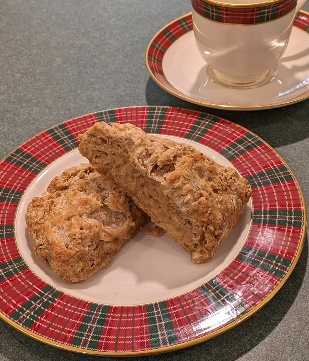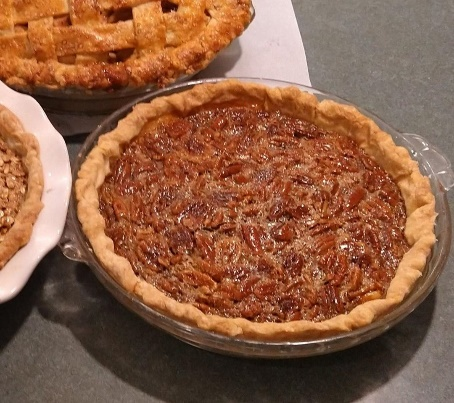By Carolyn McDonald Graf

Half a pound of tupenny (= two-penny) rice,
Half a pound of treacle.
That’s the way the money goes,
Pop! goes the weasel.
Treacle brings up memories of sweets and childhood fun. At Halloween in Scotland, a traditional task visiting children had to accomplish to win their treat was to eat a scone spread with treacle which was suspended on a piece of string at about head height. They had to do so without using their hands, resulting in treacle-covered faces.
Researching the origins of treacle is a sticky situation. Strictly speaking, treacle is the British generic name for any syrup made during the refining of sugar cane. Therefore, theoretically, Treacle, Black Treacle, Molasses, Golden Syrup, and Blackstrap are all treacles.
Treacle is a by-product of sugar refining. During the refining process, raw sugar cane is first crushed then boiled in stages until it has thickened sufficiently to facilitate the growing of sugar crystals which will eventually become refined sugar. There are two main types of treacle:
Light Treacle better known as Golden Syrup (equivalent = Light Molasses), is made from the syrup obtained during the first boiling of the sugar cane/beets. About 65% sucrose, it is the lightest in colour and the sweetest of all the treacles and is usually unsulphered.
Black Treacle, (equivalent = dark molasses) is made from the syrup obtained from later boilings and is about 55% sucrose.
There are many sites discussing the “mining” of treacle.
“Prior to mass production and refining of sugar cane in the West Indies, the only way to get hold of treacle was to mine ‘natural molasses’ in treacle mines… Black unrefined treacle forms from fossilized beds of sugar cane rather like oil or peat and has a tendency to seep and rise to the surface of the ground. This run-off is useless, but what makes the regions mentioned above unique is that the treacle is surrounded by a layer of non-porous rock that keeps it contained.
“Treacle mining goes back to pre-Roman times, in fact there was a healthy trade between England and Rome via Roman-occupied Gaul. In fact it was the main reason why the Romans wanted to conquer the unbearably cold and harsh British Isles. Why else would they want to take over an island that was uninhabitable to them? A floor mosaic from AD 77 was unearthed depicting treacle mining and refining.“
British Food: A History
There are also sites which claim that this is a fiction.
Treacle mining is the fictitious mining of treacle in a raw form similar to coal. The subject purports to be serious but is an attempt to test credulity. Thick black treacle makes the deception plausible… The topic has been a joke in British humour since the mid-19th century. One possible origin of the joke is from 1853 when 8,000 British Army soldiers were camped on Chobham Common. The camp included storehouses containing barrels. When the soldiers left for the Crimean War and the site was dismantled, they buried barrels to avoid having to remove them. Some of the barrels contained treacle and ChobhamSurrey villagers who discovered and removed them were called “treacle miners” as a joke. Local folklore about treacle mining was extended back into history back to Roman Britain.
Wikipedia
Whatever one believes about where treacle came from, it is agreed that it is a very old ingredient in Scottish recipes. Scones are such a traditional Scottish food they would be trite if they weren’t so wonderfully varied and tasty. The old, simple recipes are often the best. This one calls for treacle and specifically identifies it as molasses. It makes a lightly sweetened and spiced scone.
| 1 ½ ounce butter or margarine (3 Tbs) | ½ teaspoon ground cinnamon |
| ½ lb. (2 cups) white flour | ½ teaspoon ginger |
| ½ teaspoon baking soda | 1 teaspoon sugar |
| ½ teaspoon cream of tartar | 1 tablespoon treacle, molasses |
| Pinch of salt | ¼ pint (1/2 cup) buttermilk |

Rub the butter into the flour than add all the other dry ingredients and mix thoroughly. Heat the treacle and mix with a spoonful or so of the buttermilk. Add this gradually to the flour mixture with enough buttermilk to make a stiff dough. Knead very lightly and then roll out on a floured surface to ¾-inch thick. Shape into a round and cut into 8 triangular slices. Put on a greased baking sheet and bake at 400⁰ for 10-15 minutes. Serve warm with butter.
If you want to be confused and/or entertained do a simple search of “treacle mines” on your computer.
Golden Syrup is another form of treacle that has become more available in the US. It has a nuttier flavor than cane syrup and is a rich replacement for corn syrup especially in pecan pie!
Traditional Scottish Cookery, Theodora Fitzgibbon, The Chaucer Press Ltd, Bungay, Suffolk. 1980

